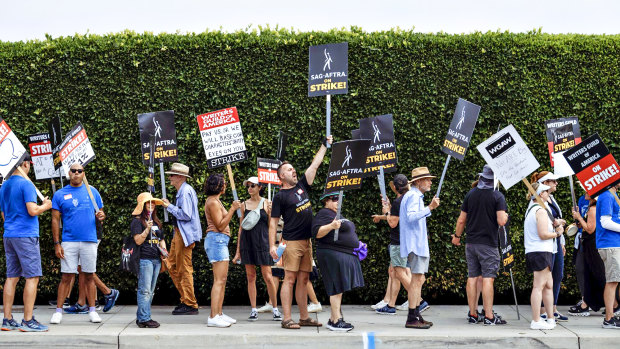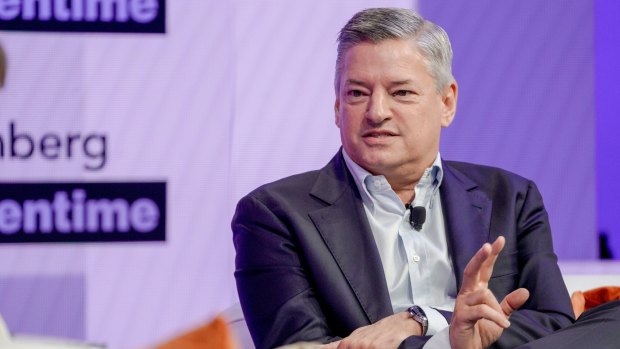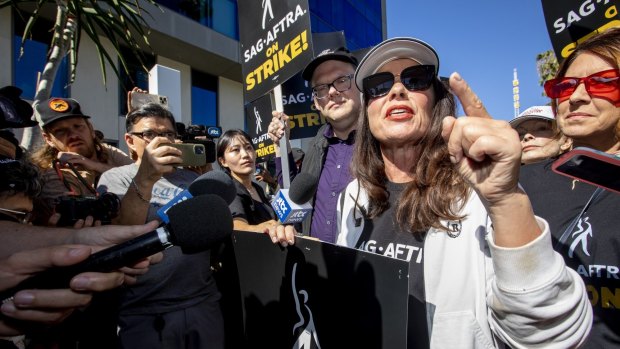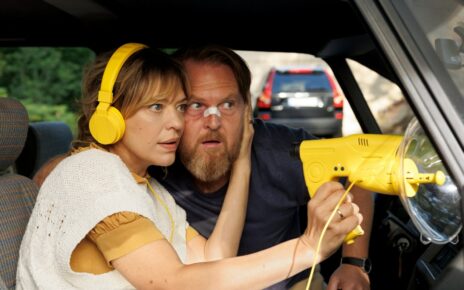Save articles for later
Add articles to your saved list and come back to them any time.
When the writers’ strike came to an end recently, many in the industry assumed the actors would follow suit. The actors’ union and the studios were in talks; they seemed to be getting along. Could a happy ending be in sight for Hollywood?
Then came this week’s unfortunate plot twist: talks have broken down.
The Alliance of Motion Picture and Television Producers, representing the studios, said it was suspending talks because they were “no longer moving us in a productive direction” after a session on Wednesday.
After the latest round of negotiations between the studios and the actors stalled, the Hollywood shutdown is set to continue.Credit: Eric Thayer/Bloomberg
In response the union, SAG-AFTRA, accused studio executives of “bully tactics” and said in a statement early Thursday that the studios presented an offer “that was, shockingly, worth less than they proposed before the strike began”.
The key sticking point is a union proposal to have their share of streaming revenue delivered as a bonus to cast members, which AMPTP says would cost $800 million a year.
SAG-AFTRA stated that figure was exaggerated by 60 per cent and that its proposal would cost the streaming platforms 57 cents per subscriber per year.
Following the breakdown, Netflix chief executive Ted Sarandos told Bloomberg’s Screentime conference in Los Angeles the levy proposal was “a bridge too far to add this deep into the negotiation”.
Ted Sarandos, president and co-chief executive officer of Netflix, during the Bloomberg Screentime event in Los Angeles.
Sarandos said: “We had offered a success-based bonus similar [to what WGA accepted]. In fact, it will cost four to five times more to implement it with SAG because of the union’s significantly larger membership of 160,000 compared to WGA’s 11,500.”
“That was rejected, and the counter was this levy on every subscriber, and before that was a levy on all revenue.”
Actors have been on strike for three months, and this week’s negotiation was the first time the sides met since July 14. SAG-AFTRA president Fran Drescher and chief negotiator Duncan Crabtree-Ireland met with the heads of major studios, including Sarandos and Disney’s Bob Iger, but could not make progress.
SAG-AFTRA president and actor Fran Drescher speaks at a strike rally in Los Angeles in July.Credit: Bloomberg
In a statement released early on Thursday, the studio alliance said it had offered wage increases, met “nearly all of the union’s demands on casting,” and proposed further protections around the use of artificial intelligence. The alliance also said it had offered “the same terms ratified” by both the writers’ and directors’ unions regarding wage increases and streaming royalties.
SAG-AFTRA is seeking an 11 per cent increase in minimum rates to keep pace with inflation.
The AMPTP is offering the same deal it gave the WGA and the Directors Guild of America — 5 per cent, followed by 4 per cent and 3.5 per cent increases.
When negotiations resumed with writers last month, their strike ended five days later.
Members of the WGA approved a new three-year contract with major studios this week, five months after the union called a strike. The new agreement provides pay raises, some protections around AI use and other gains.
Since ratifying the deal, late-night television has returned, writers’ rooms have started up again, and preproduction schedules for new films have been confirmed.
But with the actors’ strike hitting another road bump, Hollywood remains closed – for now.
Find more of the author’s work here. Email him at [email protected] or follow him on Instagram at @thomasalexandermitchell and on Twitter @_thmitchell.
Find out the next TV, streaming series and movies to add to your must-sees. Get The Watchlist delivered every Thursday.
Most Viewed in Culture
From our partners
Source: Read Full Article





